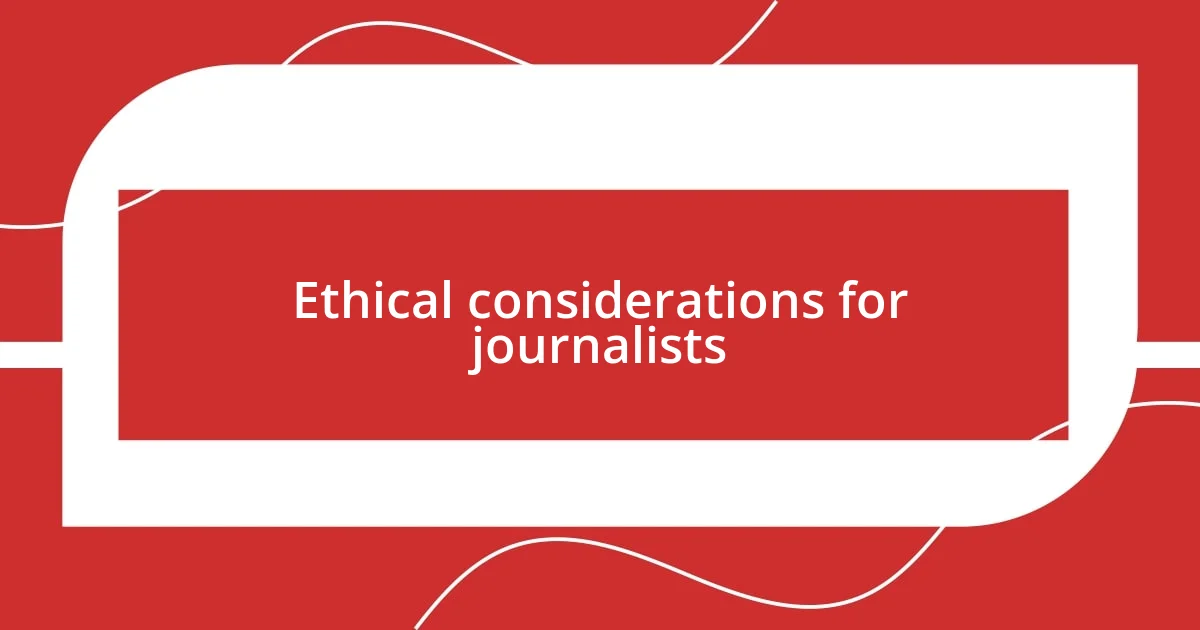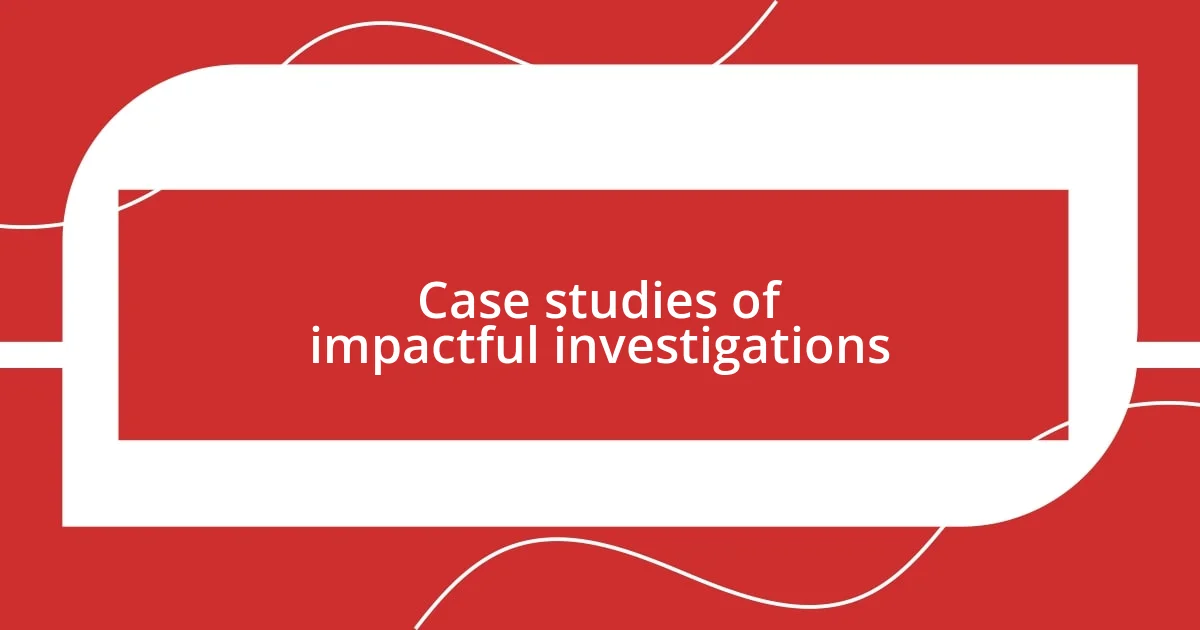Key takeaways:
- Investigative journalism today integrates traditional methods with modern technology, improving efficiency but challenging depth due to fast-paced news cycles.
- Key challenges include funding constraints, pressure for speed, safety concerns, distrust in media, and ethical dilemmas, impacting journalists’ emotional well-being.
- Future trends highlight the rise of data journalism, collaborative efforts across borders, and increased audience engagement, fostering a deeper connection with communities affected by issues.

Understanding investigative journalism today
Investigative journalism today is marked by a blend of traditional techniques and modern technology. I remember when I first started reporting, the thrill of digging deep into a story was electrifying. The resources available now, like data analysis and social media platforms, not only enhance research but also add layers to uncovering the truth. How does that shift influence the stories we choose to pursue?
The urgency of today’s fast-paced news cycle can often overshadow the meticulous work that investigative journalism demands. I find myself wondering if the pressure for immediate results compromises depth in reporting. There are moments when I’ve felt disheartened, realizing that a comprehensive investigation could take months, while headlines are created in seconds. Isn’t it fascinating how the weight of a story can sometimes get lost in the noise?
Moreover, the rise of citizen journalism adds a new dynamic to the field. I’ve been both intrigued and challenged by how ordinary people can now contribute to uncovering injustices. It’s empowering, yet I often think about the ethical implications of untrained individuals chasing down stories. Can we trust that the same rigorous fact-checking and integrity, hallmarks of professional investigative work, are being upheld?

Key challenges in investigative journalism
Key challenges in investigative journalism can often feel overwhelming, especially in today’s environment. One of the most daunting challenges I’ve faced is the dwindling resources for in-depth investigations. I recall collaborating on a significant story where we constantly juggled limited funds and tight deadlines, which made it hard to gather the necessary information. The race against time can lead to a sense of frustration; I often ponder whether our audience values deep-dive journalism as much as the quick snippets of news they encounter daily.
- Funding constraints: Many investigative teams operate on shoestring budgets, hampering their ability to undertake extensive research.
- Pressure for speed: The demand for rapid reporting can conflict with the thoroughness required for quality investigations, leading to potentially incomplete stories.
- Safety concerns: Journalists often face personal risks, especially when tackling sensitive topics, which can discourage in-depth reporting.
- Distrust in media: Growing skepticism towards traditional media sources can result in challenges when trying to engage with the community for stories or gather reliable information.
- Ethical dilemmas: The rise of citizen journalism complicates the narrative, as not all contributors adhere to the ethical standards expected in professional reporting.
Navigating these challenges often takes a toll emotionally, too. I’ve experienced a mix of excitement and anxiety as I dive into investigations, knowing that while the pursuit of truth is noble, the path can lead to isolation or burnout. It’s that internal struggle—wanting to expose wrongdoing while protecting oneself and colleagues—that can weigh heavily on a journalist’s mind.

Techniques used in modern investigations
Investigative journalism has evolved significantly, adopting various techniques that blend traditional practices with modern advancements. I remember my initial attempts at gathering information, where every phone call or interview felt like peeling an onion. Today, however, tools like public records databases and advanced data analytics allow journalists to sift through massive amounts of information quickly. This shift not only enhances the depth of reporting but also equips me to find connections between seemingly unrelated facts in a fraction of the time.
Another technique that has gained traction is the use of social media for crowd-sourcing information. I’ve often turned to Twitter or Facebook to engage with communities affected by specific issues, hoping to gather firsthand accounts. It’s astonishing how social platforms can amplify voices that might otherwise be overlooked, creating a richer narrative. Yet, I sometimes pause to reflect on the potential misinformation that swirls in these spaces. How do we discern truth when everyone is a storyteller?
Furthermore, multimedia presentations have become essential in modern investigations. I treasure the days when we relied solely on text and photographs; however, the ability to incorporate video or interactive graphics now allows us to present stories in more compelling ways. I recall a project where we integrated a video diary from a whistleblower, capturing raw emotions that words alone couldn’t convey. It struck me how this storytelling approach engaged the audience on a deeper level, humanizing the facts and drawing them into the narrative.
| Technique | Description |
|---|---|
| Data Analysis | Utilizing software to analyze large datasets for patterns and insights. |
| Social Media Engagement | Crowd-sourcing information and stories from the public via platforms like Twitter or Facebook. |
| Multimedia Storytelling | Incorporating video, audio, and interactive elements to enhance narrative impact. |

Technology’s role in investigative reporting
The impact of technology on investigative reporting is profound and transformative. I still remember how the introduction of digital tools changed my approach to research. One evening, I was sifting through a mountain of documents trying to find a smoking gun for a story. With just a few clicks and the right software, I was able to uncover patterns I would have missed otherwise, showcasing how technology saves us precious time and helps us dig deeper than ever before.
Certain digital platforms play a crucial role in connecting journalists with sources. For instance, I once tweeted a curious question about a local issue, and within hours, someone reached out with firsthand information that dramatically changed the scope of my investigation. It made me realize how important it is to embrace these platforms while being cautious about filtering out unreliable information. There’s a delicate balance here—how do we leverage technology to expand our reach while ensuring our credibility remains intact?
Furthermore, the rise of encrypted communication apps has provided a refuge for sources who may otherwise fear repercussions for speaking out. I recall a sensitive case where a whistleblower needed assurance of anonymity before sharing crucial insights. Utilizing end-to-end encrypted messaging allowed us to communicate freely without the looming worry of exposure. It’s amazing how technology serves as a double-edged sword—providing tools for transparency while also safeguarding the voices that deserve to be heard. Are we prepared to navigate this new landscape responsibly and ethically?

Ethical considerations for journalists
Ethical considerations are the backbone of investigative journalism, guiding us to uphold integrity and accountability in our work. I vividly recall a time when I was faced with a story involving a sensitive issue—my instincts pushed me to rush for sensational details, but I had to pause and remind myself of the ethical weight this carried. How would my reporting affect the individuals involved? This critical reflection is essential; every story impacts real lives and reputations.
Transparency is another cornerstone of ethical journalism. I’ve experienced the fine line between providing enough context and oversharing sensitive details. In one instance, while reporting on a government project, I withheld certain identities to respect privacy, but I provided clear information about my sources’ credibility. It was a balancing act, but it reminded me that trust is earned through honesty—not just about what we report, but how we report it. Are we willing to sacrifice sensationalism for truth and integrity?
Lastly, the principle of fairness cannot be overstated. I’ve often wrestled with my biases when covering contentious topics; it’s easy to inadvertently color a story with my personal views. During a heated election cycle, I made a conscious effort to seek multiple perspectives, ensuring that every voice was represented. It wasn’t always easy, but the outcome was worth it. By striving to present a balanced narrative, I find that readers are more likely to engage with the material and reflect on it critically. Isn’t that what we ultimately want—to foster understanding and dialogue?

Case studies of impactful investigations
One of the most striking case studies in recent investigative journalism is the Panama Papers leak. I remember the palpable buzz in the newsroom as we worked on this massive trove of documents revealing the hidden wealth of politicians and celebrities worldwide. It was a real testament to how tenacious reporting can shine a light on global corruption. The fact that this investigation was bolstered by international collaboration among dedicated journalists made it even more inspiring. Doesn’t it spark hope to see so many individuals come together for a common goal—truth?
Another powerful instance relates to the uncovering of the Harvey Weinstein scandal. The way that journalists from The New York Times and The New Yorker persisted in their investigation, ensuring that the voices of survivors were heard, struck a chord with me. I remember following the developments closely, and it made me reflect on the responsibility we carry when telling such painful stories. In my own experience, interviewing sources with personal trauma has always required sensitivity and respect—how can we honor their experience while still pursuing the quest for justice?
Lastly, the reporting on the Flint water crisis left an indelible mark on my perception of community-focused investigative journalism. I can’t shake the memory of a local journalist who devoted countless hours to uncovering the environmental negligence that poisoned an entire city. The passion and grit displayed by that journalist made me realize how vital it is to connect our work to the lives we’re seeking to improve. In an age where stories can easily be overlooked, how do we ensure that these local issues are brought to the forefront of public consciousness?

Future trends in investigative journalism
The future of investigative journalism is undoubtedly intertwined with advancements in technology. From my own experience, I’ve seen the power of data journalism grow exponentially. For instance, I was once involved in a project that utilized algorithms to sift through massive datasets. This approach not only streamlined our research process but also uncovered trends and patterns that traditional reporting might have missed. Isn’t fascinating how tools designed for convenience can lead us to profound truths?
Moreover, I sense a significant shift toward collaborative journalism. As I’ve observed within my network, journalists are increasingly banding together across geographic boundaries to tackle global issues. This collaborative spirit fosters diverse perspectives and amplifies our reach. I remember a cross-border investigation where reporters from different countries pooled their sources and expertise to expose human trafficking rings. It was an eye-opening experience; it made me realize that the fight for truth is a collective endeavor. How can we leverage this network to drive impactful change?
Lastly, the increasing emphasis on audience engagement is shaping how investigations are conducted and reported. I’ve found that involving the community in the investigative process can yield remarkable results. In one instance, I reached out to local residents for their insights on an environmental issue impacting their lives. Their experiences enriched the narrative dramatically, reminding me that the most powerful stories often come from those directly affected. What if we all embraced this approach, turning our investigative efforts into a dialogue with the very people we aim to serve?















